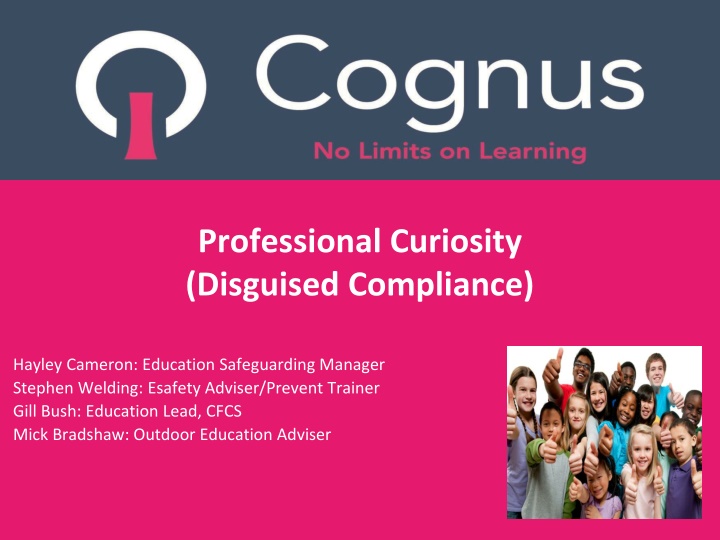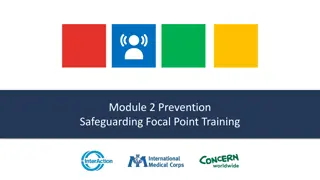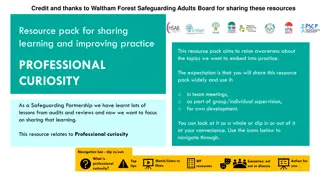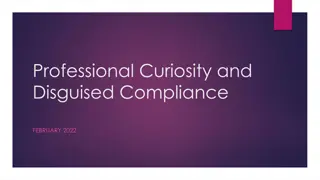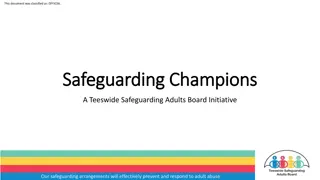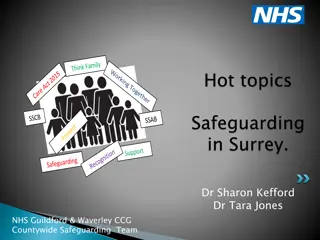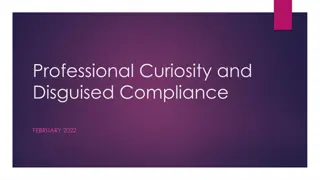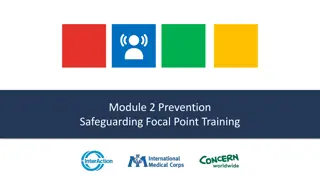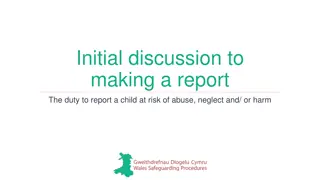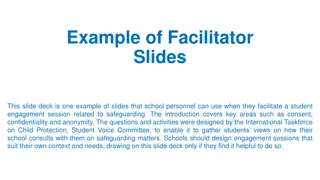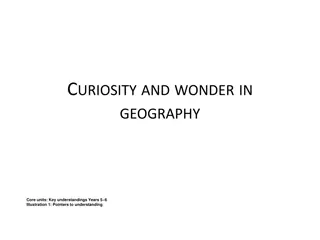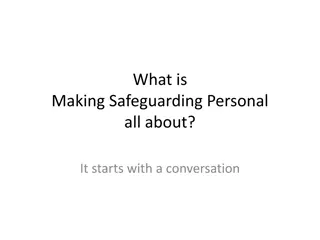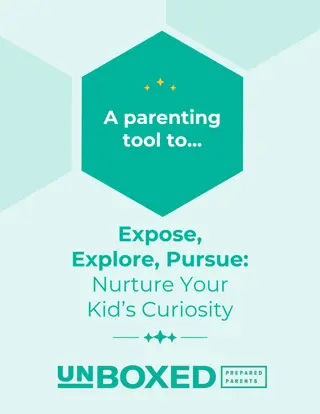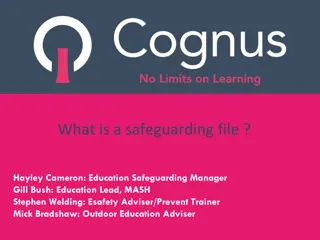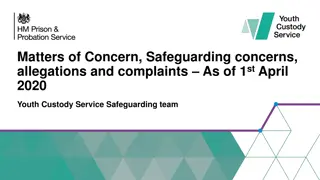Enhancing Safeguarding Practices through Professional Curiosity
Professional curiosity is crucial in safeguarding to explore beyond superficial assumptions, engage holistically with families, and ask difficult questions to protect children and vulnerable individuals effectively. Triangulating information and thinking outside the box are key strategies for safeguarding professionals to ensure thorough assessments and interventions.
Download Presentation

Please find below an Image/Link to download the presentation.
The content on the website is provided AS IS for your information and personal use only. It may not be sold, licensed, or shared on other websites without obtaining consent from the author.If you encounter any issues during the download, it is possible that the publisher has removed the file from their server.
You are allowed to download the files provided on this website for personal or commercial use, subject to the condition that they are used lawfully. All files are the property of their respective owners.
The content on the website is provided AS IS for your information and personal use only. It may not be sold, licensed, or shared on other websites without obtaining consent from the author.
E N D
Presentation Transcript
Professional Curiosity (Disguised Compliance) Hayley Cameron: Education Safeguarding Manager Stephen Welding: Esafety Adviser/Prevent Trainer Gill Bush: Education Lead, CFCS Mick Bradshaw: Outdoor Education Adviser
Professional Curiosity Professional curiosity is the capacity and communication skill to explore and understand what is happening within a family rather than making assumptions or accepting things at face value. Walsall safeguarding Board
Professional curiosity Professional curiosity is key to safeguarding children and adults be interested in the individuals you are working with and fully explore rather than making assumptions. Be aware of your own values affecting judgements. Walsall safeguarding Board
Think outside the Box Be self aware in your practice, Professional curiosity can require practitioners to think outside the box , beyond their usual professional role, and consider families circumstances holistically. Curious professionals engage with individuals and families through visits, conversations, observations and asking relevant questions to gather historical and current information Walsall safeguarding Board
Professional Curiosity Triangulate information you receive. Seek independent confirmation of individuals accounts and weigh up details from a range of sources and practitioners. Focus on the need, voice and lived experience of the person or family. Ask relevant questions and be brave . Be prepared to have difficult conversations. Walsall safeguarding Board
Those difficult questions!! Professionals need to enquire about the significant people in families lives that influence them. This may be someone who provides care, or supports the family or individual for example, another family member, a friend, someone from the community or father of any children and so on. Professionals need to be brave and have what are often difficult or awkward conversations about the issues affecting families. These could be domestic abuse, inadequate housing, self-neglect, social isolation, mental health, drugs and alcohol, or issues between a person and carer Walsall safeguarding Board
Bichard report - 2004 For those agencies whose job it is to protect children and vulnerable people, the harsh reality is that if a sufficiently devious person is determined to seek out opportunities to work their evil, no one can guarantee that they will be stopped. Our task is to make it as difficult as possible for them to succeed... Bichard Report, 2004, p 12, para 79
Definition of disguised compliance Disguised compliance involves parents giving the appearance of co-operating with child welfare agencies to avoid raising suspicions and allay concerns. Published case reviews highlight that professionals sometimes delay or avoid interventions due to parental disguised compliance. Walsall safeguarding Board
Disguised Compliance Families can develop skilful strategies to keep professionals at 'arms length'. Disguised compliance occurs when parents want to draw the professional's attention away from allegations of harm and unsafe parenting with the aim of minimising or avoiding agency interventions in family life. Walsall safeguarding Board
Indicators of Disguised Compliance Parents put little effort into making any changes There is limited improvement despite significant input Parents align with certain professionals Parents only engage with part of the plan Child s view conflicts with that of the parents view Cases begin to drift and lack focus Significant issues may be missed The risk to the child may increase Cases may be closed too early CHILD REMAINS AT RISK OF HARM
Learning from Safeguarding Practice reviews Establish the facts and gather evidence Build Chronologies Record the child s perspective Identify the outcomes Use staff supervision to challenge beliefs
Why is all of this important? It is important for children to receive the right help at the right time to address safeguarding risks, prevent issues escalating and to promote children s welfare. Research and Safeguarding Practice Reviews have repeatedly shown the dangers of failing to take effective action. Examples of poor practice include: failing to act on and refer the early signs of abuse and neglect poor record keeping failing to listen to the views of the child failing to re-assess concerns when situations do not improve not sharing information with the right people within and between agencies sharing information too slowly a lack of challenge to those who appear not to be taking action.
SO WHY ARE WE HERE TODAY?? We can all make a difference to a child s life. We can all help a child to achieve. We can all listen to what a child is telling us. We can all be there for the child. We can provide the best support for the child. We all know right from wrong . WE ALL HAVE TO BE PROFESSIONALLY CURIOUS
Summary - Establish the facts Use in-depth assessments to gather evidence about what is actually happening. Observe what is being said but also remember to look for non- verbal cues e.g. body language and parent/child interactions. Keep detailed records and build up a chronology - this will help with looking for patterns of non-compliance. Look at previous records to identify patterns of behaviour/engagement. Remember that previous history is the best predictor of future behaviour. Talk to other professionals. What are their experiences of the family? Coordinate information across families for a fuller picture of what life is like for the child. Avoid being over optimistic about a parent s ability or motivation to change. Hampshire Safeguarding Authority
Thank You for Listening Please visit www.Cognus.org.uk where you will find more bitesize training packages. Hayley Cameron: Education Safeguarding Manager Stephen Welding: E safety Adviser/Prevent Trainer Gill Bush: Education Lead, CFCS Mick Bradshaw: Outdoor Education Adviser
